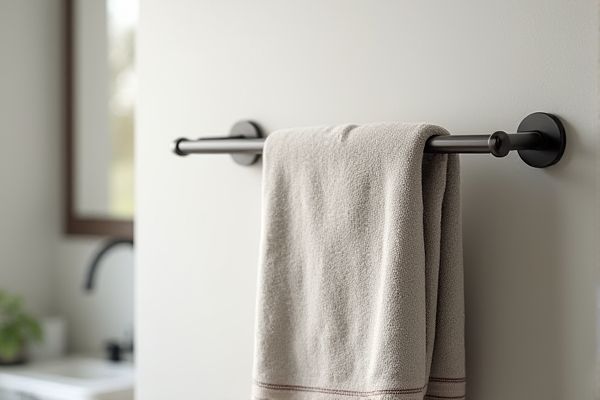
A towel bar provides ample space for larger towels to hang flat, promoting faster drying, while a towel ring is compact and ideal for hand towels, saving space in smaller bathrooms. Discover which option suits Your bathroom needs best by reading the rest of the article.
Table of Comparison
| Feature | Towel Bar | Towel Ring |
|---|---|---|
| Design | Long horizontal bar | Small circular ring |
| Towel Capacity | Holds large/larger towels | Holds hand towels or small towels |
| Installation Height | Typically 48 inches from floor | Typically 48 inches from floor, often near sink |
| Space Usage | Requires more horizontal wall space | Compact, fits small walls/spaces |
| Best Use | Bathroom or kitchen for bath towels | Near sink for hand towels |
| Material Options | Metal, wood, plastic | Metal, wood, plastic |
| Installation Type | Wall-mounted with screws or adhesive | Wall-mounted with screws or adhesive |
| Cost | Usually higher price | Usually lower price |
Towel Bar vs Towel Ring: Key Differences
Towel bars offer more space for hanging full-sized towels and promote faster drying due to better air circulation, making them ideal for larger bathrooms. Towel rings are compact and stylish, designed primarily for hand towels or smaller spaces, fitting well next to sinks or vanities. Choosing between a towel bar vs towel ring depends on your bathroom size, towel usage, and aesthetic preferences for optimal functionality.
Pros and Cons of Towel Bars
Towel bars provide ample space for drying larger towels, promoting better air circulation which reduces mildew buildup, making them ideal for frequently used bathrooms. They require more wall space and can sometimes limit towel drying efficiency if towels are folded unevenly, while also demanding sturdier installation to support weight. Assess your bathroom layout and drying needs to determine if a towel bar fits your space and drying preferences better than a towel ring.
Pros and Cons of Towel Rings
Towel rings offer a compact and stylish solution for holding hand towels, making them ideal for small bathrooms or powder rooms where space is limited. They allow for easy access and quick drying due to their open design but may not support heavier or larger towels as securely as a towel bar. However, towel rings can sometimes cause towels to become bunched up, reducing airflow and prolonging drying time compared to towel bars.
Best Uses for Towel Bars
Towel bars are ideal for holding larger bath towels and drying them evenly due to their extended length, which prevents bunching and promotes airflow. They work best in bathrooms with enough wall space for multiple towels or for families needing ample hanging room. Installing towel bars near sinks or showers enhances convenience while keeping towels neat and accessible.
Ideal Situations for Towel Rings
Towel rings are ideal for compact bathrooms or powder rooms where space is limited, offering a sleek solution for hand towels near sinks. They provide easy access and maintain towel shape, preventing unnecessary dragging or contact with the floor. Perfectly suited for guest bathrooms or areas requiring minimal towel storage while enhancing aesthetic appeal.
Space Considerations for Towel Bars and Rings
Towel bars require more horizontal wall space, making them ideal for larger bathrooms or areas with ample room between fixtures. Towel rings are compact and fit well in tight spaces, perfect for small bathrooms or next to sinks where space is limited. Choosing the right option depends on your bathroom layout and how efficiently you want to use available space.
Design and Style Comparison
Towel bars typically offer a sleek, linear design that complements modern and traditional bathroom styles by providing ample space for hanging multiple towels, enhancing functionality and aesthetic appeal. Towel rings present a more compact, circular design ideal for small bathrooms or powder rooms, adding a stylish, minimalist touch while occupying less wall space. Both options are available in a variety of finishes such as chrome, brushed nickel, and oil-rubbed bronze, allowing seamless coordination with existing bathroom fixtures.
Installation Process: Bar vs Ring
Towel bars typically require two mounting points, often necessitating wall studs or anchors for stability, making the installation process more involved compared to towel rings, which usually have a single mounting bracket and are easier to install on drywall. Towel bars measure between 18 to 30 inches in length, demanding precise leveling and spacing for proper functionality, whereas towel rings generally have a compact 6 to 8 inches diameter, simplifying placement in small or tight spaces. Installation tools for both include drills, screws, and anchors, but towel rings often require less time and effort due to their simpler design and fewer mounting points.
Maintenance and Cleaning Differences
Towel bars typically require less frequent cleaning due to their larger surface area, making it easier to wipe down dust and grime. Towel rings often collect moisture more quickly, necessitating more regular cleaning to prevent mildew and rust, especially in humid bathrooms. Your choice may impact how much time you spend maintaining a clean, hygienic bathroom environment.
Which One Should You Choose?
When deciding between a towel bar and a towel ring, consider your bathroom size and the type of towels you frequently use. Towel bars are ideal for larger towels and provide ample space for drying multiple items, while towel rings suit smaller towels and compact spaces. Choosing the right option ensures your bathroom remains organized and functional, enhancing your daily routine.
 homyna.com
homyna.com